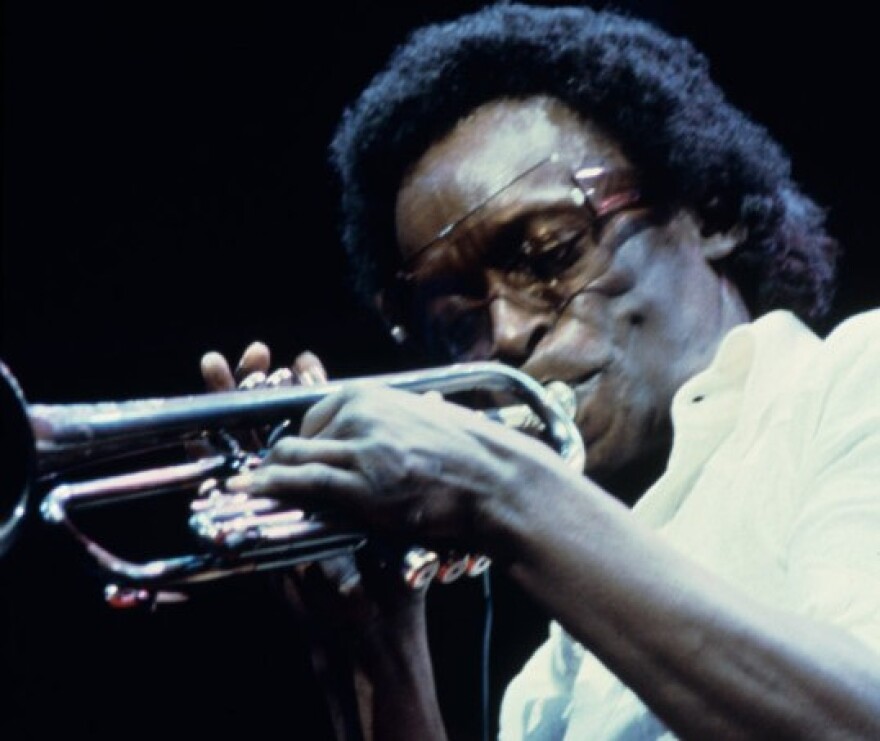In 1987 Miles Davis was a reluctant guest at a White House awards dinner. He was seated next to a woman he describes in his autobiography as “a politician’s wife.” During their conversation she asked him what he’d done in his life that was so important. “Well,” he said. “I’ve changed music five or six times.”
That wasn’t an idle boast. Davis was one of the most important figures in jazz history. Throughout his fifty-year career, he was either at the forefront or in the thick of just about every major development in jazz from be-bop to jazz-rock fusion. Many jazz greats like Louis Armstrong or Duke Ellington developed a radical new style and then spent the rest of their careers developing and refining it. Davis, on the other hand, restlessly searched and strove for something new and different. He was unparalleled in jazz.
As a trumpeter, Davis eschewed virtuosity in favor of a lean, spacious, personal style. “Don’t worry about playing a lot of notes,” he said. “Just find one pretty one.”

He had unmatched skill as a bandleader. Two of his groups rank among the best ever (First Great Quintet, 1955-1958; Second Great Quintet, 1964-1969) and the number of future jazz greats who came up through his bands is astonishing: saxophonists John Coltrane, Cannonball Adderley and Wayne Shorter; pianists Bill Evans, Herbie Hancock and Chick Corea; drummers Philly Joe Jones, Tony Williams and Jack DeJohnette; guitarists John McLaughlin and John Scofield.
His first important records as a leader are the Birth of the Cool sessions of 1949-1950. They had a light, airy, tightly arranged sound that was in stark contrast to the frenetic bop Davis played during his apprenticeship with alto saxophonist Charlie Parker.
After helping to establish cool jazz, Davis grew tired of it and turned to the more aggressive sounds of hard bop as played by what's known as his First Great Quintet (John Coltrane, sax; Red Garland, piano; Paul Chambers, bass; Philly Jo, drums). Next, his modal explorations on 1959’s Kind of Blue album freed soloists from the constraints of chords. The subtly radical and richly melodic Kind of Blue remains the biggest selling jazz album of all time.
Davis’ Second Great Quintet came together in late 1964 when saxophonist/composer Wayne Shorter joined the trumpeter’s band. This group took elements of avant-garde and free jazz to create a looser, open style that’s referred to as post bop. It’s a style of jazz that remains dominant today.
As the 1960s came to an end, Davis began experimenting with electronic instruments and rock rhythms. The albums In a Silent Way and Bitches Brew feature long compositions pieced together from different takes by Davis and producer Teo Macero. Davis was accused of selling out, but the music was challenging, experimental and furthered the post-bop innovations of the Second Great Quintet.After a five-year hiatus, Davis returned to music in 1980. Even though he was now a jazz elder statesman, the restlessness that had defined his career continued. He refused to look back even though some musicians, critics and fans wished he’d play music from his older albums like Kind of Blue. But Davis said he had no feel for it anymore and said it was like warmed-over turkey. Instead, he found inspiration in the sounds of the time and his music incorporated pop, funk, electronica and, on his final album, hip-hop.

If I wanted to establish my cred as the ultimate cool and hip jazz radio host, I’d say that my favorite Miles Davis records are his early ‘70s abstract funk albums. But this is my least favorite period in his ever-changing career. These records are too meandering and unfocused for my taste. They’re more like avant-garde audio collage spliced together from long jams. The albums weren’t received very favorably at the time, but have grown in esteem since then. It’s been many years since I’ve heard them, so maybe it’s time to give the records another, closer listen.
My favorite Miles Davis period is 1956-61, which is his most popular. These were also the years he collaborated with arranger Gil Evans in a series of albums that are essentially trumpet concertos with jazz orchestra. They didn’t transform jazz like Davis’s other works, but they’re masterpieces nonetheless. My favorite is Porgy and Bess, which features Evans’ inventive arrangements of Gershwin’s music providing an evocative backdrop to some of Davis’ most expressive and just plain beautiful playing. It’s filled with pretty notes.
Interestingly, not long before his death, Davis, who didn’t like to look back, revisited his collaborations with Evans in a 1991 concert at Montreux. But it may have been more of a heartfelt tribute to Evans, one of his closest friends who died three years earlier, than an uncharacteristic nostalgic exercise.
Given Miles Davis’s myriad of styles and approaches and restless musical experiments, there is plenty of music to explore. And that’s what we’re doing on SDPB in February. On Thursday, Feb. 13 the JAS Quintet joins Jazz Nightly for a live performance of Davis’s music drawn from throughout his career. And SDPB-TV features award-winning filmmaker Stanley Nelson’s new documentary Miles Davis: Birth of the Cool on Tuesday, Feb. 25 at 8 pm (7, MT).


